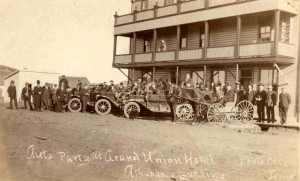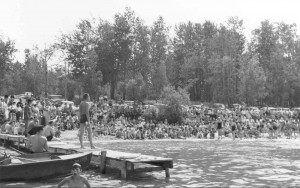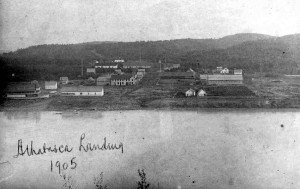The Athabasca region enjoys much depth and richness in our heritage. The region was first settled as the Hudson’s Bay Company’s “headquarters of northern transportation” and “gateway to the north”, which brought much economic growth to the community of Athabasca Landing (now known as Athabasca). Similarly, the historic Athabasca Landing Trail played a significant role in the region’s expansion in the late 1800s and development of agriculture as an economic driver, and the Government of Canada played a role in the establishment of Amber Valley, a community of black refugees from the United States. For a more in-depth look at the region’s history, visit the Athabasca Archives or contact the Athabasca Heritage Society to purchase one of their publications.
(Photo Left: courtesy Athabasca University | Photo Right: courtesy Athabasca Archives)
Athabasca Landing Trail & the Railway
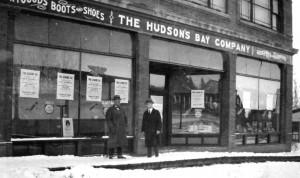 The Athabasca region saw increased settlement in the late 1800s through the use of the Athabasca Landing Trail, then used by Aboriginal hunters travelling north to hunt buffalo. Once the Canadian National Railroad reached Calgary in 1883, goods were shipped to Edmonton, then to Athabasca Landing where they were loaded onto steam boats and carried down the Athabasca River. Hudson’s Bay Company, one of several outfitters with a vested interest in the booming fur trade, made some improvements to the trail, which saw hundreds of Klondikers travel its dirt path in 1897 and 1898 on their way to strike it rich. From then on, homesteaders came by the thousands to settle the area. Eventually some enterprising individuals saw
The Athabasca region saw increased settlement in the late 1800s through the use of the Athabasca Landing Trail, then used by Aboriginal hunters travelling north to hunt buffalo. Once the Canadian National Railroad reached Calgary in 1883, goods were shipped to Edmonton, then to Athabasca Landing where they were loaded onto steam boats and carried down the Athabasca River. Hudson’s Bay Company, one of several outfitters with a vested interest in the booming fur trade, made some improvements to the trail, which saw hundreds of Klondikers travel its dirt path in 1897 and 1898 on their way to strike it rich. From then on, homesteaders came by the thousands to settle the area. Eventually some enterprising individuals saw 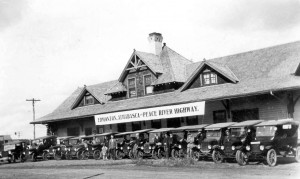 a business opportunity on the trail and established a few public facilities in Rochester (then called Ideal Flats), Perryvale (then Lewiston), Meanook (a Cree word meaning ‘good camping place’), and Colinton (then Kinnoull) to serve travellers. Canadian National Railway built a line along this trail on the way to Athabasca Landing in the early 1900s. The train station in Athabasca still stands and is currently undergoing renovations to restore its original charm.
a business opportunity on the trail and established a few public facilities in Rochester (then called Ideal Flats), Perryvale (then Lewiston), Meanook (a Cree word meaning ‘good camping place’), and Colinton (then Kinnoull) to serve travellers. Canadian National Railway built a line along this trail on the way to Athabasca Landing in the early 1900s. The train station in Athabasca still stands and is currently undergoing renovations to restore its original charm.
The Village of Boyle wasn’t established until 1914 when the railroad was being laid on the way to McMurray. It was chosen by the rail company as a town site – perhaps an 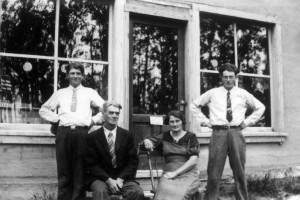 unconventional decision as the outlying area was low and swampy. However, it was chosen to be an important link to Northern exploration supported by the train. The residents of Boyle District soon turned to grain growing, lumbering, and services. The population of Flat Lake gradually moved into Boyle. The village saw their first church service in March 1916 in a homesteader’s flour shed. However, the 30 degree below weather and lack of heat meant that the organ froze, leaving the hymns at that first service to be sung a capella!
unconventional decision as the outlying area was low and swampy. However, it was chosen to be an important link to Northern exploration supported by the train. The residents of Boyle District soon turned to grain growing, lumbering, and services. The population of Flat Lake gradually moved into Boyle. The village saw their first church service in March 1916 in a homesteader’s flour shed. However, the 30 degree below weather and lack of heat meant that the organ froze, leaving the hymns at that first service to be sung a capella!
Photo Top: Courtesy Athabasca University
Photo Middle: Courtesy Athabasca University
Photo Bottom: Courtesy Athabasca Archives
Athabasca Landing
Famous Canadian poet Robert Service wrote about his visit to Athabasca Landing in 1911:
“Athabasca Landing was then a huddle of shacks; but it was booming, and that night at the hotel it was difficult to get a seat for dinner….The next day was spent in preparations for our departure. The Landing was abustle with spring activity and the Company was the centre of all movement.”
Robert Service, Ploughman to the Moon
Incorporated in 1911 as Athabasca Landing, legend has it that David Thompson was the first to arrive at this location in 1799 with only two First Nations guides, a prayer book, and a sextant. By 1892, trading posts and missions along the Athabasca River had been taking place for around 15 years. Boatbuilding began to develop – for ma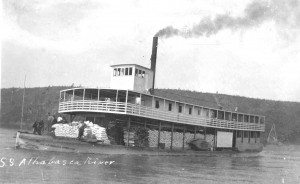 ny years, it was a primary industry for Athabasca Landing. A flurry of activity each spring built scows, sternwheelers, and steamboats to support trade and travel along the river. The scows would hold around 10 tons of goods and were manned by the “Athabasca Brigade” – the Metis and Indian boatmen who navigated the rocks, ledges, and rapids of the river. The Hudson’s Bay Company’s SS Athabasca was the first steamboat built and launched at Athabasca Landing.
ny years, it was a primary industry for Athabasca Landing. A flurry of activity each spring built scows, sternwheelers, and steamboats to support trade and travel along the river. The scows would hold around 10 tons of goods and were manned by the “Athabasca Brigade” – the Metis and Indian boatmen who navigated the rocks, ledges, and rapids of the river. The Hudson’s Bay Company’s SS Athabasca was the first steamboat built and launched at Athabasca Landing.
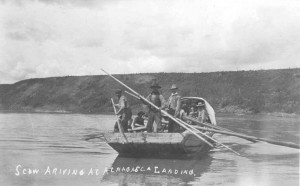 When word of the Klondike Gold Rush hit in 1898, 600 prospectors took the Landing Trail to Athabasca Landing and the townsite grew from 26 residents to more than 2800 tents and shacks. Steam paddle wheelers, barges, and countless canoes headed up and down the Athabasca River, and the town was a flurry of activity.
When word of the Klondike Gold Rush hit in 1898, 600 prospectors took the Landing Trail to Athabasca Landing and the townsite grew from 26 residents to more than 2800 tents and shacks. Steam paddle wheelers, barges, and countless canoes headed up and down the Athabasca River, and the town was a flurry of activity.
Photo Top: Courtesy Athabasca Archives
Photo Middle: Courtesy Athabasca University
Photo Bottom: Courtesy Athabasca Archives
The Growth of Agriculture
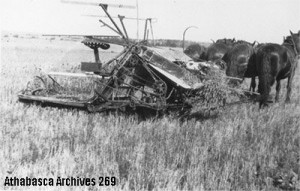 The beautiful valley to the east of the Athabasca Landing Trail was alluring to the travelling pioneers. The rolling countryside, heavily populated with trees and bottomless muskeg, eventually became the Flat Lake District where homesteaders provided oats and hay to the freighters and their teams making the journey north to Athabasca Landing before the railway was completed. Many settlers were attracted to the hay meadows in this area, but some continued East to Skeleton Lake and Ellscott.
The beautiful valley to the east of the Athabasca Landing Trail was alluring to the travelling pioneers. The rolling countryside, heavily populated with trees and bottomless muskeg, eventually became the Flat Lake District where homesteaders provided oats and hay to the freighters and their teams making the journey north to Athabasca Landing before the railway was completed. Many settlers were attracted to the hay meadows in this area, but some continued East to Skeleton Lake and Ellscott.
Just north of the Flat Lake District, the hamlet of Grassland wasn’t settled until the fur trade was ending in the late 1890s. The Lac La Biche Trail and the Waterways Trail saw major upgrades in order to improve access to farmland, and Grassland formed a local government around 1905.
Similarly, Wandering River (then known as Muskeg-Prairie) opened for homesteading in 1927. Settlers moved in from Saskatchewan and Alberta, eager to try their hand at farming in a new community. Many abandoned their old homesteads and filed for new property in the area without having seen it beforehand – and were surprised to find that the road from Plamondon was solid mud for more than 30 km and took more than a week to travel! Despite these hardships, the settlers were happy; summers were spent clearing land and making hay, while the winters passed with card playing, dances, and parties.
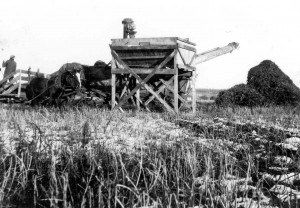 In the spring of 1914 a group of settlers arrived in the area between Plamondon and present-day Atmore from the town of Gourin in the Morbihan department of Brittany, France. The families homesteaded multiple quarter sections and would assist in the development and growth of the surrounding communities of Plamondon and Atmore by building infrastructure, businesses, schools, and churches. Along with the many other French-speaking families who subsequently established themselves in the vicinity, the pioneers opened the once rugged land and expanded the area’s agricultural production.
In the spring of 1914 a group of settlers arrived in the area between Plamondon and present-day Atmore from the town of Gourin in the Morbihan department of Brittany, France. The families homesteaded multiple quarter sections and would assist in the development and growth of the surrounding communities of Plamondon and Atmore by building infrastructure, businesses, schools, and churches. Along with the many other French-speaking families who subsequently established themselves in the vicinity, the pioneers opened the once rugged land and expanded the area’s agricultural production.
(Photo Top: Courtesy Athabasca Archives | Photo Bottom: Courtesy Athabasca Archives)
Amber Valley
The Amber Valley settlement just East of Athabasca Landing was home to a significant population of black refugees from Oklahoma. They were attracted to Canada due to the opportunity to settle free land, vote in elections, and live free of injustice and discrimination. While the latter wasn’t entirely true, it was certainly an improvement over conditions in the United States.
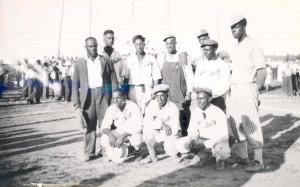 By 1910, Amber Valley had a population of around 300 residents and within ten years had a modest 38 acre farm established. The Amber Valley baseball team played in the Northern Alberta Baseball League and community members enjoyed participating in the local chamber of commerce, agricultural society, women’s societies, and public service. Unfortunately, there was little support from the Canadian government to allow family members and former neighbours to cross the border, so the population dwindled to a fraction of what it once was.
By 1910, Amber Valley had a population of around 300 residents and within ten years had a modest 38 acre farm established. The Amber Valley baseball team played in the Northern Alberta Baseball League and community members enjoyed participating in the local chamber of commerce, agricultural society, women’s societies, and public service. Unfortunately, there was little support from the Canadian government to allow family members and former neighbours to cross the border, so the population dwindled to a fraction of what it once was.
 Perhaps Amber Valley’s most famous resident, J.D. Edwards was one of the first settlers. He left Oklahoma in 1910, and once he reached Edmonton he walked 160 kilometres north to stake his claim. Edwards embraced his citizenship with pride, actively participating in local politics, school and hospital boards. He was a founding member of the Alberta Wheat Pool, and was the driving force behind the formation of the Amber Valley Baseball team. In 1973, he received an Achievement Award in Humanities from the Alberta government in honour of his many contributions to the local community. He passed away in 1979 at the age of 90, a proud Canadian citizen and fine example of the pioneering spirit of black settlers in Western Canada.
Perhaps Amber Valley’s most famous resident, J.D. Edwards was one of the first settlers. He left Oklahoma in 1910, and once he reached Edmonton he walked 160 kilometres north to stake his claim. Edwards embraced his citizenship with pride, actively participating in local politics, school and hospital boards. He was a founding member of the Alberta Wheat Pool, and was the driving force behind the formation of the Amber Valley Baseball team. In 1973, he received an Achievement Award in Humanities from the Alberta government in honour of his many contributions to the local community. He passed away in 1979 at the age of 90, a proud Canadian citizen and fine example of the pioneering spirit of black settlers in Western Canada.
Today, Amber Valley is well known for its twice annual chicken suppers, monthly music jams, and yearly baseball tournaments. A small museum is open by appointment to interested visitors.


